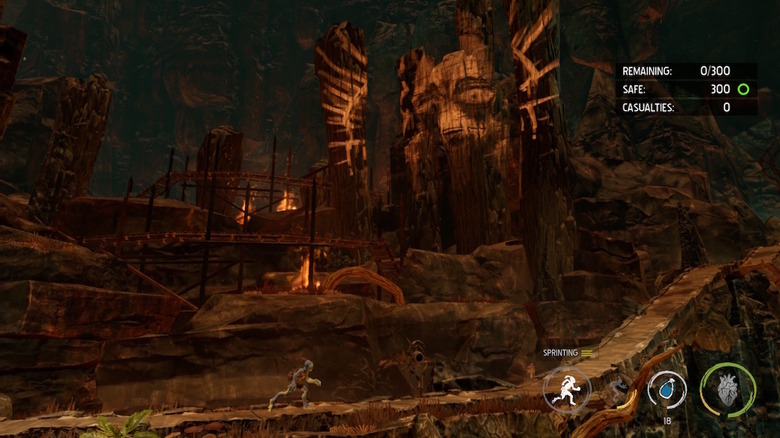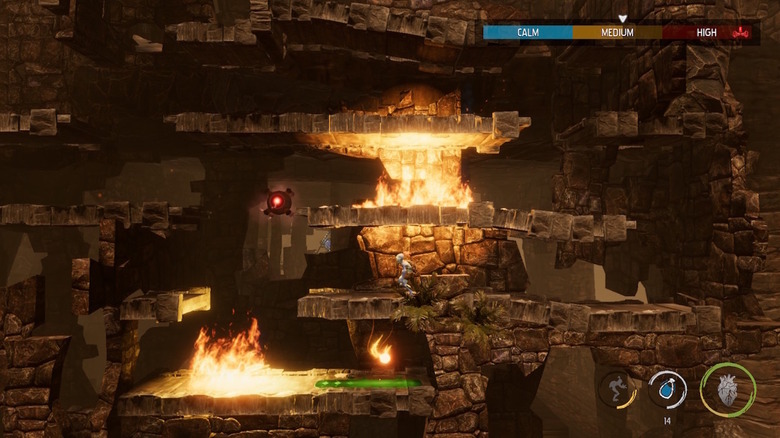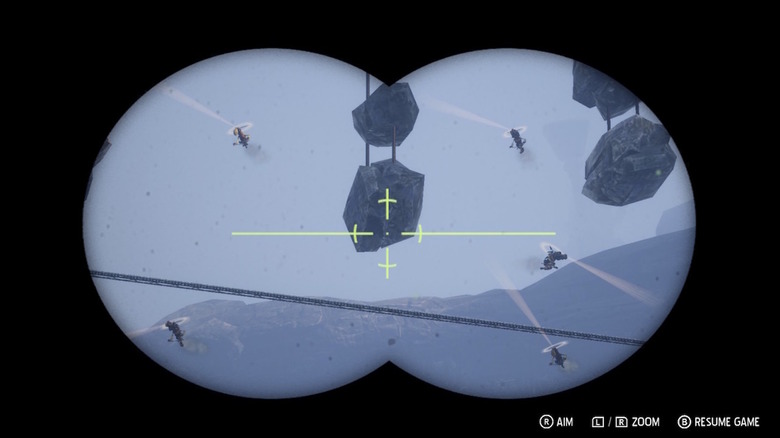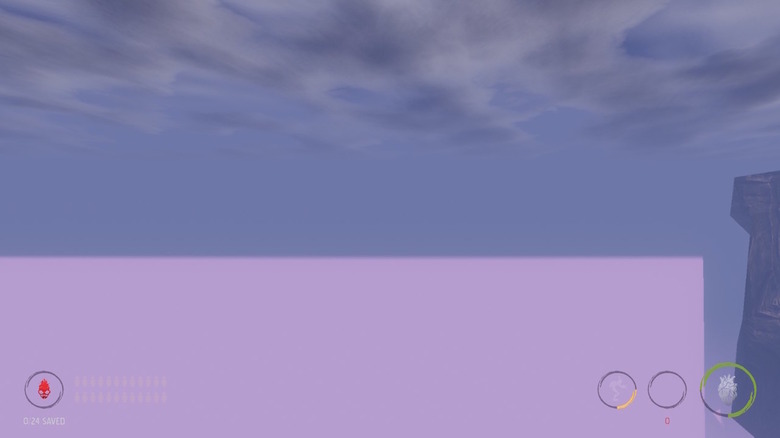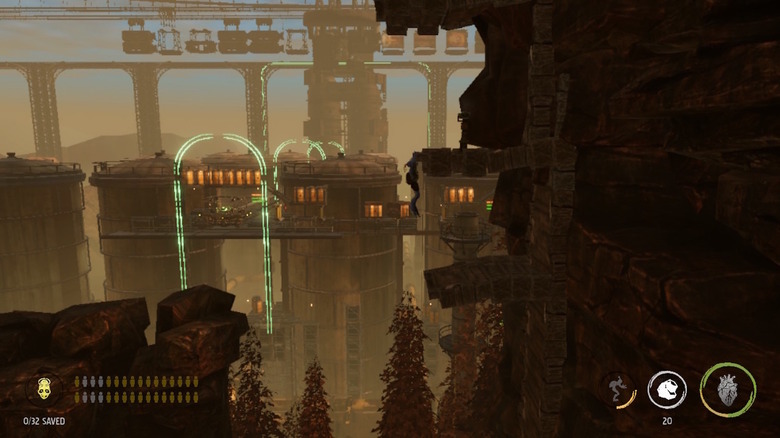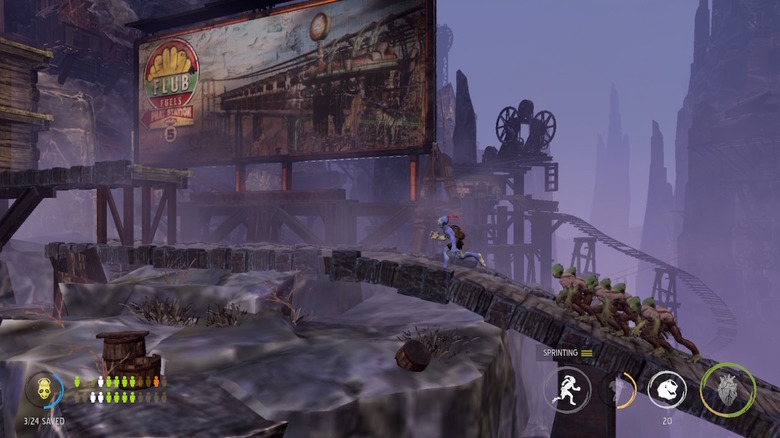Oddworld: Soulstorm (Switch) Review: Some Patience Required
- More “classic style” Oddworld to explore
- Abe has a few more handy tricks at his disposal
- Gets a lot more enjoyable once it finds its footing
- Has an incredibly weak (and irritating) start
- Items and supplies don’t carry over between levels
- A bit too much tedious waiting and time-wasting
- Level design checkpoint placement pale vs. original game
I have a somewhat complicated relationship with the "Oddworld" series. I was utterly captivated by the cinematic nature, bleak world, and bizarre character designs the second I took control of Abe in that initial playable demo that came with the first issue of PlayStation Underground all the way back in 1997. Since I was very young at the time I lacked the skill and patience to actually beat the full game (or its sequel, "Abe's Exoddus"), but I was still incredibly fond of them and would often start a fresh game just to see how far I could make it.
"Munch's Oddysee" had my attention and anticipation right up until I actually played it — then I fell off almost immediately. "Stranger's Wrath" is the first title in the series I ever finished, but it's a wholly different style of game compared to the puzzle-platformer rescue missions of the earlier games so I don't know if it really counts.
But now we have the utterly stellar 2014 remake of the first game, "New 'n' Tasty," so an all-new "Oddworld" follow-up when we've already been given such a fantastic modern update is something to be excited about. Right? Maybe it was unreasonable to expect "Soulstorm" to build off of that remastered concept. Maybe too much time has passed, I don't know. I wanted more classic-style Oddworld and more Abe, and technically that's what I was given, but it seems like my expectations were a bit too high.
There's a storm comin'
For its part, "Soulstorm" has a decent setup. The story starts in media res (partway through) with a good hook that raises a fair number of questions, then jumps back several in-game days where Abe's newest adventure really kicks off. The cinematics look stellar, the voice acting is, well, what you'd expect from "Oddworld," and it piqued my interest pretty thoroughly.
Things went downhill really fast once I was put in control of the action, though — and only started climbing out of that ditch roughly three or so levels in.
I can appreciate wanting to start the game with a somewhat bombastic setpiece moment, especially in today's market where the default tends to be "look at the explosions!" Problem is, it doesn't suit "Soulstorm." I don't think it's an out-of-place concept for an "Oddworld" story, but the game itself just can't quite handle what I think Oddworld Inhabitants wanted to accomplish.
Sure you could argue that it's because "this game is too much for the Switch" or whatever, but I'm not talking about lower-resolution textures or video stuttering (though "Soulstorm" does have those). I'm talking about still animations, floaty platforming controls, and... to be honest, the introductory level kind of feels tacked on. It's an awkward, stilted, not very well-paced tutorial that's far more frustrating than fun. And it's the very beginning of the game. And unfortunately, things don't improve much once you finish learning the ropes.
We really need to talk about the level design...
It doesn't feel quite right
To be clear, there are elements to the level design in "Soulstorm" that I appreciate. Many of the stages are pretty expansive and give you ample opportunity to explore or show off some impressive vistas (which admittedly look a bit drab on the Switch but the attempt is still appreciated). But many of these levels just don't seem to have the same amount of heart in them as the earlier games — or the remake.
Things absolutely do improve, with later areas providing more visual interest, branching paths, introducing new mechanics, and so on. But the first "proper" level you're tossed into is a fairly drab canyon with puzzles that feel simultaneously too easy to figure out and too easy to mess up. Then once you do mess up, it's back to the checkpoint and spending a minute or two tediously re-doing everything in an attempt to get past the one part that was a problem. It's not helped by the fact that the checkpoints are often poorly placed, requiring more tedious time wasting every time Abe meets an untimely end.
What frustrates me the most about this is how it gets significantly better the longer you stick with it. Once you clear those first few lackluster levels the game actually starts to get — dare I say it — fun. I can't help but wonder what the heck happened here. I understand why the puzzle and platforming challenges get more complicated as the game progresses, but why are they also so much better?
Hurry up and wait
Even the pacing of the earlier levels is baffling. This is the beginning of a game that (presumably) you want players to stick with to the end. Why is it front-loaded with so much waiting?
Waiting for enemies to get into position so you can clear them out. Waiting for enemy alertness to lower so they go back to sleep and you can sneak around safely. Waiting for characters to shout at each other over vast differences in a cutscene that was probably supposed to be funny, but just kills your forward momentum for a couple of minutes. Waiting to heal sick allies.
Seriously though, that whole "antidote" thing with the sick mudokons. It's the first time in "Soulstorm" that you can finally Do The Thing and have Abe rescue and recruit his fellows — good and proper "Oddworld" stuff — and it happens on level freaking four — or three if you don't count the tutorial stage as a level! And even then, everyone's sick, so first you have to scour various parts of the level for ingredients in order to craft an antidote — yes there's crafting, I'll get to that.
And once you do that, you then have to stop in front of each sick mudokon and press the interact button (often more than once because Abe doesn't like to do things unless he's lined up just right and has finished his movement animation), wait for them to stand up, and then you can be on your way. This is not what I'd consider an ideal way to introduce one of the most significant mechanics in the classic series.
A smaller, bigger world
Another thing I've noticed while making my way through this particular hemisphere of Oddworld is that, despite the levels feeling larger, the world itself doesn't. The areas Abe traverses are undeniably big — even vast — but there's so little enemy variety, at least early on, when compared to even the very first game on the original PlayStation.
Now, I love Sligs, inasmuch as anyone could love violent slugs with robotic legs and finger-mouths. But there's, again, a lot of game between the opening and seeing anything other than one of those trigger-happy snot-colored dorks. And when you do finally encounter, say, your first slog (basically a lizard dog that's like 80 percent teeth), it's in a dark cave so you can't really appreciate the spectacle — or sorely-needed variety — very much. There are also bats, which are just flittering shapes in the air and don't seem to have any proclivity for darkness versus daylight.
Whereas in the original "Abe's Oddysee" you encounter slogs and scabs (creatures that are basically just sentient claws that can move) fairly early on. And then Paramites (kind of like carnivorous hands?). And other kinds of slig. Granted, "Soulstorm" does offer multiple slig types, at least, but again, it takes a while to encounter most of them.
This lack of upfront enemy variety makes "Soulstorm" feel like it takes place in a much smaller world — despite being set in the exact same one as its predecessors — by comparison. Sometimes it feels like I'm wandering through a cul-de-sac rather than an alien wilderness.
Even more nits to pick
I wish I was done griping about "Soulstorm" but unfortunately there's still more to talk about. The game is sprinkled with irritating bugs that may or may not be exclusive to the Switch version, I just don't know, but they definitely don't help matters. I've had a cutscene play but the video didn't load properly so I just saw a black screen but still heard the audio. And then that same level loaded with the game camera pointed at some random part of the sky so I couldn't see anything — I had to reload the checkpoint for things to line up properly again.
Supposedly you can toss rocks at bats to get rid of them and make them drop venom sacs but despite the game's insistence they never drop anything. Snipers are supposed to be avoidable if you manage to stay out of their obvious laser sights, but in a couple of places on one level at least one sniper would always zero in on me the moment I was in the open regardless of whether or not I'd been spotted up to that point. Some enemies can be captured when unconscious, but sometimes Abe wraps them up and other times he just searches them for supplies — and both can happen in the same level, with no apparent rhyme or reason.
Then there's the other stuff I just plain don't like, such as not keeping your items or crafting supplies between levels. Oh, but keys are consistent — and act as an excuse to go back and replay earlier stages.
It's not all bad
All of this isn't to say that "Soulstorm" is an irredeemable waste, or even bad, really. Despite my (many, many) misgivings it does still provide something akin to what I've come to expect from an Abe-helmed "Oddworld" game. The character and world designs — especially as you get farther in — continue to be top-notch. The larger levels provide a grander sense of scale, as well as a sense of freedom to explore every inch in search of hidden health upgrades, supplies, or lost mudokons.
And while there are definitely some missteps here, I do appreciate some of the new ideas that have been included for Abe's latest outing. Being able to scavenge for supplies in lockers, garbage bins, boxes, etc compliments and encourages that sense of exploration. Using scavenged supplies to craft helpful (and sometimes necessary) items is also a neat touch, and gives you a little more leeway when it comes to navigating some areas. Why sneak past an enemy if you can use a stun mine to knock them out and capture them? Being able to free-aim when controlling some enemies is cool and makes it all the more satisfying to clear the path ahead.
Even the core mechanics like dialog commands and stealth have been cleaned up a bit. Now you can tell mudokons to follow or wait by tapping (for one) or holding (for all) a direction on the D-pad, rather than having separate buttons for singles or multiples. And unlike even the revered (at least by me) "New 'n' Tasty," holding the sneak button muffles all of Abe's movement — even jumping or dropping from a ledge.
Oddworld: Soulstorm verdict
It probably seems like it but I don't hate "Oddworld: Soulstorm" and I'm not mad at it. I mean I was mad at it, at first, because of that inexplicably rough start, but ultimately it's fine. I might even go so far as to say that I'm liking it now that my expectations have been balanced out and I've stubbornly forced my way past the bland and irritating, into much more interesting and compelling territory.
The problem is that it requires so much patience and stubbornness to begin with. Well, that and it just doesn't hold a candle to "Abe's Oddysee," "Abe's Exoddus," or "New 'n' Tasty." This may not be totally fair but it's difficult not to have those expectations seeing as this is the first new "Oddworld" since 2014. There was such a solid foundation already. I feel like it should've been fairly simple (not to say game development is easy — it's incredibly difficult and any game that makes it out the door is a miracle) to expand on what was already there. And I suppose we technically did get more, but that "more" doesn't quite measure up.
Ultimately, I do appreciate the new elements "Soulstorm" brings to the series — like the larger levels, scavenging for supplies, and crafting. And I want to play more of it on my Nintendo Switch in an attempt to go back and rescue all the mudokons and find all the secrets. But it's still disappointing that, after all this time and despite being alright, it manages to fall so short.

